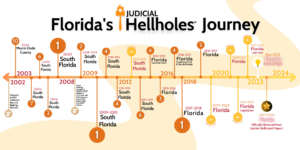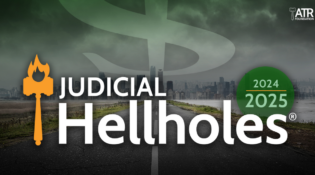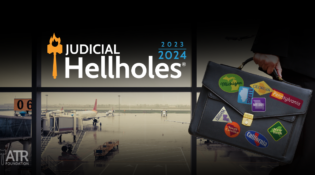
This report’s Points of Light typically comprise noteworthy actions taken by judges and lawmakers to stem abuses of the civil justice system not detailed elsewhere in the report.


This report’s Points of Light typically comprise noteworthy actions taken by judges and lawmakers to stem abuses of the civil justice system not detailed elsewhere in the report.
 In their 2023 legislative sessions, nine states enacted significant reforms to address excessive liability and litigation abuse.
In their 2023 legislative sessions, nine states enacted significant reforms to address excessive liability and litigation abuse.
Florida has a long history as a “Judicial Hellhole®,” with a legal system that has been plagued by excessive litigation, frivolous lawsuits, fraudulent claims, and outrageous awards. Florida was named the No. 1 Judicial Hellhole® in 2018 and No. 2 in 2019.
Several state Supreme Court appointments made by Governor Ron DeSantis were a catalyst for positive change, resulting in ATRF removing Florida from the Judicial Hellholes® list in 2020. However, the Florida Legislature remained on the report’s “Watch List,” due to the need to make important improvements in the civil justice system, such as addressing transparency in damages.
At long last, Florida’s leadership, including Governor DeSantis, House Speaker Paul Renner and Senate President Kathleen Passidomo, prioritized civil justice reform, recognizing the negative impact lawsuit abuse is having on Florida residents and the state’s economy. The 2023 legislative session brought a great sea change for the state’s civil justice system. Florida lawmakers passed legal reform bills that have the potential to rebalance the state’s legal system for many years to come.
The most significant of the bills, H.B. 837, sponsored by Representatives Tommy Gregory and Tom Fabricio and Senator Travis Hutson, among other things, requires transparency in damages presented in court trials. During a trial, Florida jurors currently only hear evidence of the initially invoiced amount of medical expenses, which is essentially a “sticker price,” often three or more times the amount ultimately paid. This results in a large gap between the two amounts. Under the prior system, some lawyers and allied medical clinics would inflate the damage award, hide the true value of medical expenses from the court through misuse of “letters of protection,” and collect larger fees. H.B. 837 ensures jurors receive accurate information on the actual value of medical expenses.

Other highlights of the bill include:
In the days leading up to the enactment of H.B. 837, trial lawyers rushed to courthouses around the state to file tens of thousands of cases in hopes of cashing in on the old system one last time.
In addition to H.B. 837, Governor DeSantis signed S.B. 360, sponsored by Senator Travis Hutson, into law in April. The bill shortens the timeframe within which a construction defect claim must be filed from ten to seven years and clarifies when the timeline begins. Florida was an outlier, and this bill brings it more in line with a majority of the states.
Finally, Florida enacted legislation aimed at regulating deceptive practices in legal services ads. Lawyers spent an estimated $271.8 million on TV, outdoor, radio, digital, and print ads for local legal services or soliciting legal claims in Florida. The state accounted for nearly 12% of all legal services advertising spending across the United States last year.
A 2019 FDA study shows the real-life consequences of deceptive trial lawyer ads. The report found 66 incidents of adverse events following patients discontinuing the use of blood thinner medication (Pradaxa, Xarelto, Eliquis, or Savaysa) after viewing a lawyer advertisement. The median patient age was 70, and 98% stopped medication use without consulting their doctor. Thirty-three patients experienced a stroke, 24 experienced another severe injury, and seven died.
The new law prohibits such practices as presenting lawsuit ads as “medical alerts,” suggesting a product has been recalled when it has not, displaying government logos that suggest the agency has endorsed or backed information in the ad. It also requires ads targeting FDA-approved prescription drugs or medical devices to indicate that the product remains approved, if that is the case, and warn viewers that they should consult a physician before making any decision regarding prescribed medication or medical treatment.
The significance of these enactments cannot be overstated and the ATRF commends the state’s leadership for prioritizing these issues and working to create a more fair and balanced civil justice system in Florida.
Eight additional states enacted significant reforms including:
It is well established that at the center of any tort action, there must be a cognizable “injury-in-fact,” or an invasion to one’s legally protected interest. Generally, the injury must be both “concrete and particularized” and “actual or imminent.” Recently, various state courts have considered whether an increased risk of harm for an injury, absent a present physical injury, can satisfy this requirement.
In late August, a unanimous Delaware Supreme Court definitively stated that a plaintiff cannot recover expenses for medical monitoring of a hypothetical injury without the present manifestation of a physical illness. The underlying case was brought by a plaintiff on behalf of a class of Delaware residents living next to Atlas Point, a surfactant manufacturing plant owned by defendant Croda, Inc. The Environmental Protection Agency had suggested that residents living in the zone surrounding the plant were “up to four times more likely to develop cancer than the average American” due to their exposure to the chemical, ethylene oxide. Plaintiffs’ lawyers ran to the U.S. District Court for the District of Delaware with this statistic, attempting to recover costs for monitoring nearby residents’ yet-to-exist illnesses. The federal trial court dismissed the case and, once the issue landed in the state high court’s lap, that court was equally unenthused.
The Court cited both federal and state case law in arriving at its conclusion that a fear of disease or injury does not amount to a legally cognizable injury. Notably, the Court highlighted the public policy concern that allowing recovery for hypothetical risks of future injuries opens the floodgates to limitless and unpredictable litigation. Quoting from the U.S. Supreme Court’s 1997 decision in Metro-North Community Railroad v. Buckley, the opinion observes that “’tens of millions of individuals may have suffered exposure to substances that might justify some sort of substance-exposure-related medical monitoring,’” but may never result in any actual harm. A ruling that grants undue recognition to no-injury claims could also siphon resources from those presently suffering from a physical injury or those who actually develop a medical condition in the future. While the Court acknowledged that awarding medical-surveil- lance damages could alleviate future medical costs for economically disadvantaged plaintiffs, it rightfully held that the legislature is better situated to address the thorny nuances that accompany recognizing medical monitoring a separate cause of action.
The New Hampshire Supreme Court reached a similar conclusion this past year, holding that increased risk of illness as a result of alleged exposure to a toxic chemical is not a compensable injury. In its review of the traditional elements of a negligence action, the Court determined that the “mere existence of an increased risk” is not sufficient to state a claim for damages given that there is no “present physical injury” alleged. The Court similarly emphasized the importance of leaving complex questions like this to the legislature. As recently as 2020, the New Hampshire legislature had considered establishing a cause of action for medical monitoring, but the bill was vetoed. In this case, the Court was unwilling to overstep its bounds and accomplish through judicial action what trial lawyers were unable to achieve through democratic means.
Expert testimony that is founded upon speculative conclusions, questionable methodology, and otherwise junk science is notorious in talcum powder litigation. This trend has seen a handful of repeat offenders appearing in trials across various jurisdictions, including California, Missouri, and New Jersey. However, a recent appellate decision in New Jersey offers a glimmer of hope by reaffirming the importance of rigorous expert vetting by trial court judges.
The underlying case consolidated the claims of four plaintiffs who alleged that their long use of Johnson & Johnson’s talcum products exposed them to asbestos, causing them to develop mesothelioma. The 2019 trial, overseen by Judge Ana Viscomi of the Middlesex County Superior Court, featured testimony from three plaintiff experts. Notably, Judge Viscomi felt no need to conduct hearings to assess the admissibility of their testimonies and denied Johnson & Johnson’s requests to do so. Ultimately, the trial culminated in a massive jury verdict of $224 million against Johnson & Johnson.
In October, the New Jersey Court of Appeals tossed the verdict, and with it, the testimonies of all three experts. It found that the trial court abused its discretion by failing to exercise its “gatekeeping function” in keeping out unreliable expert testimony. Dr. James Webber and Dr. Jacqueline M. Moline both testified that non-asbestiform cleavage fragments could cause mesothelioma, but the panel held that neither expert adequately explained the facts or methodology upon which they relied to arrive at their conclusions. Dr. William Longo, meanwhile, extrapolated the extent of asbestos exposure each plaintiff experienced due to their use of Johnson & Johnson products, but the panel remained unconvinced that his methodology was sound or widely accepted in the scientific community.
This decision marks the second time that the New Jersey appellate court reversed a multi-million talcum verdict on grounds of unreliable expert testimony. In a 2021 case, Lanzo v. Cyprus Amax Minerals Co., the panel similarly excluded the testimonies of Dr. Weber and Dr. Moline, which had been allowed in by the very same Judge Viscomi.
All three experts are popular picks for the mass tort bar, especially for testifying against Johnson & Johnson. In addition, Dr. Moline is the subject of a lawsuit that Johnson & Johnson’s subsidiary filed against her in May. The company alleges that she persistently and knowingly disseminated false and disparaging statements tying its products to cancer, perpetuating years of asbestos litigation underscored by her dubious claims.
The New Jersey appellate panel’s refusal to allow junk science to slip through the cracks is commend- able, and ideally, will invite other state courts to more thoroughly examine expert testimony.
“Anchoring” is a tactic that personal injury lawyers use to manipulate juries into reaching damage awards that far exceed levels they would reach if left to decide an amount based on the evidence presented at trial, and their life experience and values. This year, the Texas Supreme Court firmly rejected one particularly outrageous attempt at jury manipulation.
Anchoring implants in the minds of jurors either an arbitrary amount or suggests use of a mathematical formula (such as an amount per day or hour) designed to lead to excessive awards. While any category of damages may be influenced by anchoring, the practice has the greatest impact on noneconomic dam- ages because these awards are highly subjective. Empirical research and trial experience confirm that an “anchor” creates a psychologically powerful baseline for jurors struggling with assigning a monetary value to pain and suffering. Once a lawyer provides an anchor, jurors either accept the suggested amount or “com- promise” by negotiating it upward or downward.
In January 2023, the Texas Supreme Court rejected an attempt at anchoring that should be emulated by other courts. In that instance, the state high court ordered a new trial after a plaintiffs’ lawyer, in a tragic auto accident case, referenced the values of objects with no connection to the case, including the $71 million cost of a Boeing F-18 fighter jet and the $186 million auction price of a coveted painting by Mark Rothko. The lawyer then suggested that the jury award the families, for mental anguish and loss of companionship, two cents for every one of the 650 million miles the defendant’s trucks drove during the year of the accident (because “I’ve been trying to give this company and their lawyers my two cents worth”). In that instance, the jury awarded $38.8 million, an amount that the state high court observed matched the “two cents” suggestion “within one-half of one percent.”
The Court observed that the plaintiffs’ lawyers presented no evidence at trial supporting the $38.8 million award. Rather, the only arguments made to justify it were these “impermissible appeals to irrelevant considerations.” The Court rejected the invitation to allow juries to rely on such arbitrary figures or to essentially permit lawyers to “pick and number” and ask the jury to “put it in the blank.” As the Court understood, “The self-evident purpose of these anchors . . . is to get jurors to think about the appropriate damages award on a magnitude similar to the numbers offered, despite the lack of any rational connection between reasonable compensation and the anchors suggested.” The Court observed that “unsubstantiated anchors like those employed here have nothing to do with the emotional injuries suffered by the plaintiff and cannot rationally connect the extent of the injuries to the amount awarded.” It concluded that “unsubstantiated anchors” are not “the type of information a jury can rightfully rely on when crafting a verdict” because they “are of no assistance in rationally explaining why the amount of noneconomic damages awarded reasonably compensates a decedent’s family.”
The Texas Supreme Court instructed lower courts that they have an obligation to prevent improper jury anchoring, applying a rule of civil procedure that requires attorney arguments to be confined to the evidence and arguments of opposing counsel.
In addition to seeking compensation for hypothetical injuries like an increased risk of harm, plaintiffs’ attorneys also have tried to expand the duty owed by employers as another way of opening businesses up to limitless liability. One such example occurred in Speedway v. Jarrett, in which the plaintiff sought to hold a gas station convenience store liable for an auto accident caused by a new employee who was under the influence of illicitly obtained prescription drugs. The accident occurred an hour after the employee’s shift had ended, seven miles away, while the employee was running a personal errand. It was undisputed that the employer was not aware of the employee’s drug use, which she had hidden. Nevertheless, because the employee appeared tired at work and the employer asked her to work an extra hour, the plaintiff alleged that the store engaged in “affirmative conduct” that created a risk of harm and had a duty to stop its employee from driving at the end of her shift. A West Virginia jury found the employer at fault for 30% of the resulting damages, in excess of $2 million.
The employer challenged the verdict, arguing that it owed the plaintiff no duty of care and was not responsible for an employee’s negligent conduct outside of work. The West Virginia Supreme Court of Appeals agreed in a unanimous opinion, ruling that an employer cannot be held liable for the actions of employees acting outside the scope of their employment. The Court declined to find that the employer had engaged in affirmative conduct that created a foreseeable risk of harm. It distinguished the case from situations in which an employer provided an employee with alcohol or required an employee who warned his supervisor that he was exhausted to continue to work an extraordinarily lengthy shift. Here, the employer was not even aware of the employee’s drug abuse and had asked the employee if she would like to leave early, an offer she declined. Thus, the Court reasoned that the plaintiff had failed to show the employer “created an unreasonable risk of harm to the motoring public,” and had no duty to prevent the employee from driving.

On January 6, 2025, ExxonMobil filed a lawsuit against California Attorney General Robert Bonta in Texas federal court in response
Judicial Hellholes
Make America Healthy Again, a battle cry for Donald Trump’s presidential campaign, is an important idea that is now being
Judicial Hellholes
The changes to Federal Rule of Evidence 702 last year were supposed to be a watershed moment for expert testimony
Judicial Hellholes